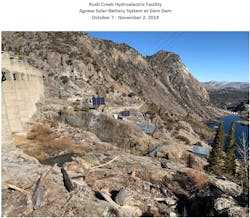California Utility Builds Solar Microgrid in 27 Days to Avert Wildfires in Sierra Nevadas
A solar microgrid, built in 27 days in cold and windy weather, was Southern California Edison’s (SCE) solution to an urgent need to avert wildfires near a remote dam in the Sierra Nevada mountains.
SCE installed the solar microgrid in rugged terrain 8,900 feet above sea level in frigid conditions. Courtesy of SCE
Installing the microgrid in November allowed the utility to turn off a line that provided power to the site of the Gem Dam, part of the Rush Creek Hydroelectric Facility, located 8,900 feet above sea level close to Yosemite National Park, said Sarah Loyola, major construction project manager for SCE and the project.
The line powered valves, emergency backup, cameras and other equipment needed to ensure the dams were running properly.
“We turned off the line and came up with an alternative way to power the site that was independent of the grid,” said Loyola.
The microgrid, completed in early November, includes two 3.3 kW solar arrays, a 600-amp, 48-volt storage system and a propane backup generator.
Genesis of solar microgrid
SCE removed the line after detecting wildfire risk, said Stephanie Fincher, generation branch lead for the project.
“The genesis of this microgrid solution stems from one of our efforts doing inspections for wildfires,” she said. “We uncovered some issues with the line that posed a wildfire risk.”
The power line that posed the risk connects the Rush Creek powerhouse and the Gem Dam, she said.
“The team needed a creative solution that could be deployed quickly,” said Fincher. The high elevation, time pressure and difficulty accessing the site created the urgency.
“We had to get it installed before snow would block out availability to do anything,” she said.
In general, SCE inspects electrical infrastructure for anything that could be wrong with the line or vegetation too close to the line, she said.
“We couldn’t just turn the line off and leave the facility without power in the dark. The line supplied emergency power if there was an issue. Without it, we wouldn’t have any visibility into the dam.”
Hike or helicopter only
The company filed requests for expedited project approval from the Federal Energy Regulatory Commission (FERC) and the US Forest Service. Both agencies agreed, responding to the wildfire risk and dam safety concerns, said Pincher.
The company was in a rush because it needed to complete the project before snow began falling and access to the site became limited. In addition, work had to be finished before the spring melt, when the dam’s reservoirs would start filling up and would need to be monitored closely, she said.
The line provided power that allowed for lake level monitoring, said Loyola. SCE measures the snowpack and the flow of the water to ensure the dam and powerhouse are working correctly.
The company finished the solar microgrid in 27 days in spite of numerous challenges, said Loyola. “It’s a high Sierras elevation. Gem dam is on the border of the wilderness boundary, and there are no access roads. You have to hike in or helicopter.”
Solar microgrid installed in the Sierra Nevadas. Courtesy of SCE
Building a microgrid in frigid temperatures at 9,000 feet
The mornings were about 6 degrees while the crew waited for helicopters to warm up. The diesel-powered field truck didn’t operate well in the cold. And the team had trouble getting the helicopter to fly to 9,000 feet.
“The construction team was up there 27 straight days, 7 days a week, in high winds and other inclement weather challenges,” said Loyola. At times, it was unclear whether the helicopter could land at the site.
With the time clock ticking, SCE had to re-design the solar microgrid after checking to ensure the panels would receive enough sunlight.
“We found that in December and part of January, there was no sunlight in the original location we looked at. We had to quickly change the design.” said Loyola.
What’s more, winds of up to 100 miles per hour posed challenges; the company didn’t want any equipment to be unstable.
Trial by fire
Given the lack of sun in certain areas and the high winds, SCE decided to reduce the footprint of the design, installing 18 panels instead of the originally planned 22 panels, said Loyola.
To date, the solar plus storage microgrid has done its job in this pilot project, powering the site with no need yet to use the propane generator.
“This is a pilot; we are evaluating this. It’s a trial by fire here with the elevation and the snow and wind conditions that the site faces,” said Fincher.
Interested in solar microgrids? Read more by subscribing to the free Microgrid Knowledge newsletter.
About the Author
Lisa Cohn
Contributing Editor
I focus on the West Coast and Midwest. Email me at [email protected]
I’ve been writing about energy for more than 20 years, and my stories have appeared in EnergyBiz, SNL Financial, Mother Earth News, Natural Home Magazine, Horizon Air Magazine, Oregon Business, Open Spaces, the Portland Tribune, The Oregonian, Renewable Energy World, Windpower Monthly and other publications. I’m also a former stringer for the Platts/McGraw-Hill energy publications. I began my career covering energy and environment for The Cape Cod Times, where Elisa Wood also was a reporter. I’ve received numerous writing awards from national, regional and local organizations, including Pacific Northwest Writers Association, Willamette Writers, Associated Oregon Industries, and the Voice of Youth Advocates. I first became interested in energy as a student at Wesleyan University, Middletown, Connecticut, where I helped design and build a solar house.
Twitter: @LisaECohn
Linkedin: LisaEllenCohn
Facebook: Energy Efficiency Markets

